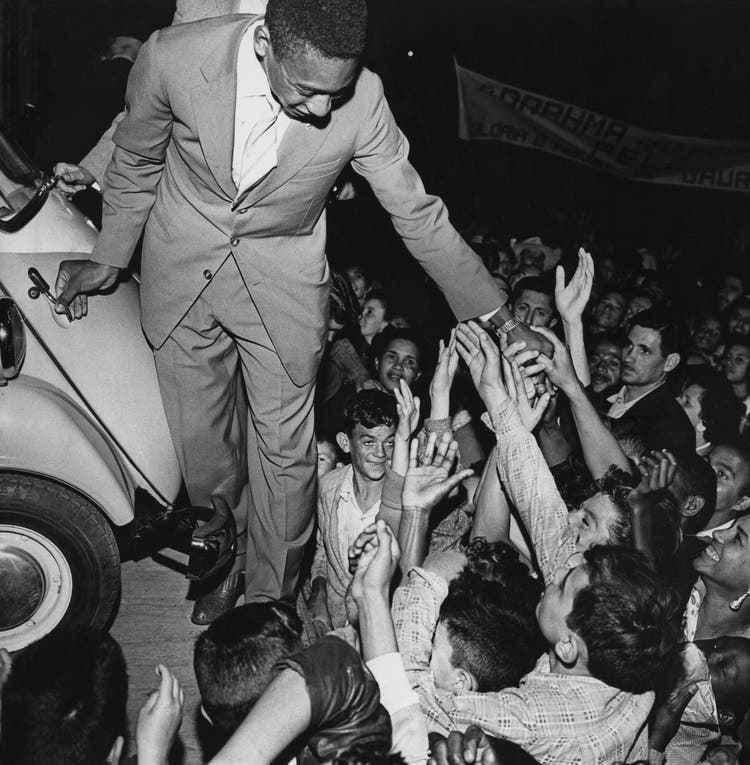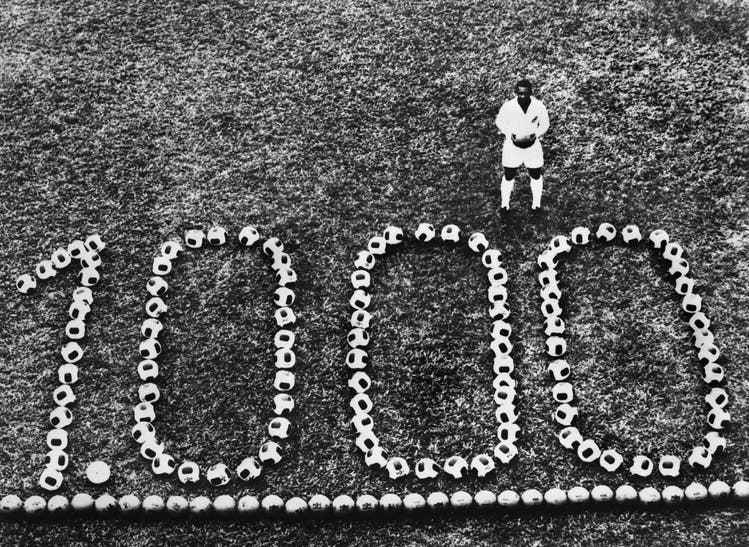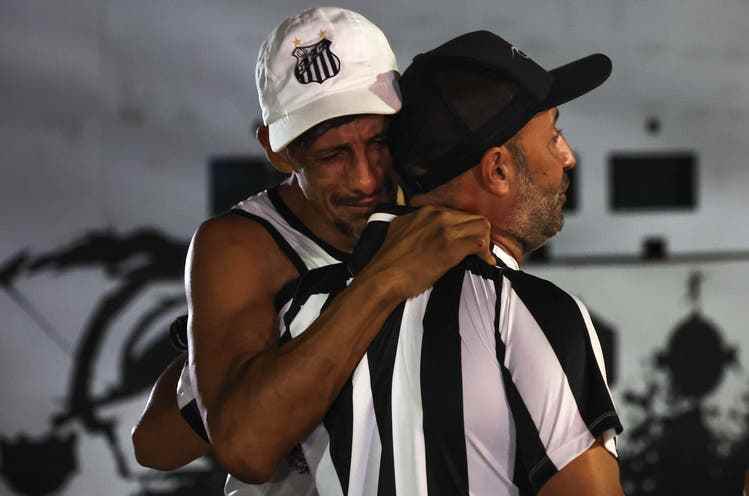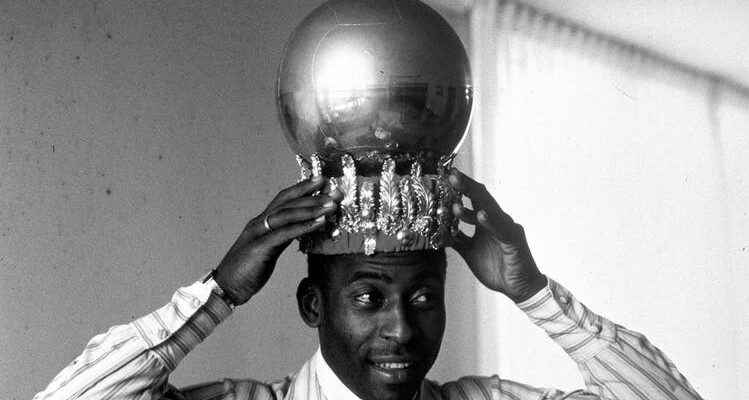The fact that Edson Arantes do Nascimento was silent about racism and the crimes of the dictatorship was resented in his Brazilian homeland. His alter ego, the miracle striker Pelé, will remain immortal.
In 1970, after scoring 1,000 goals, Pelé emerged as the king of football.
Brazil mourns Pelé. But you are prepared, the only player who has won the world championship three times has been ill for a long time. Ever since he was taken to the hospital at the end of November, it was clear that Brazil’s football king was about to say goodbye. And so everything was prepared for the sad moment.
The one-hour main news of the largest TV station Globo on Thursday evening was dedicated exclusively to the memory of the legend. Rio’s statue of Christ lit up in yellow and green, and President Jair Messias Bolsonaro ordered three days of national mourning.
Pelé made Brazil visible and raised its status in the world, footballer Neymar wrote on Instagram. President-elect Luiz Inácio Lula da Silva thanked Pelé for taking the name of Brazil “to the four corners of the world”.
Pelé was Brazil’s answer to the Beatles
Many Brazilians share this feeling of gratitude. The then 17-year-old miracle striker Brazil scored their first World Cup title at the 1958 World Cup in Sweden. It was the founding moment of modern Brazil; finally one felt taken seriously by the world.

Fans pay homage to Pele after winning the 1958 World Cup.
That victory erased the ignominy of losing the 1950 home World Cup when tiny neighbor Uruguay snatched the title from Brazil at Rio de Janeiro’s Maracanã Stadium. The defeat produced a “stray dog complex”, a feeling of inferiority and a lack of self-confidence, even a shame at being Brazilian.
That was over now, Brazil and Pelé seemed to be doing everything. Bossa nova conquered the world from Rio de Janeiro, and Pelé and his club, FC Santos, celebrated incomparable magic football on their tours around the world. Pelé was Brazil’s sporting answer to the Beatles, like them he was a global mass phenomenon of the lively 1960s. And the Brazilians liked it when the whole world bowed in reverence to someone from their country.
Above all, Pelé shaped the positive image of Brazil worldwide. Brazilian journalist Xico Sá writes in his obituary that Pelé invented the idea that the whole planet had of Brazil in the first place. “Pele is the compensation God has given our country for not receiving a Nobel Prize.”
Three marriages, all to white women
When the world was at Pelé’s feet, he was always the object of criticism at home. And probably also from envy. Being successful is seen as a personal insult in Brazil, said Tom Jobim, the composer of “Girl from Ipanema”. This is especially true when a black boy from a poor background wants to become the king of Brazil, the most racist country in the world, black rapper Emicida added.
So the press took a close look at Pelé’s private life. There were three marriages – all with fair-skinned women – as well as infidelities and love affairs like the one in 1981 with a 17-year-old blonde TV starlet. Pele was 41 years old then. For black men who are with white women, the Brazilian vernacular has a terrible, racist name ready: They are “palmiteiros”, like the tree of the white palm hearts. In other words, these men had internalized the prejudices of the white colonists, according to which light-skinned women were to be preferred.

Pelé in 1966 with his then-wife Rosemeri.
More than almost any other country, Brazil has been shaped by the trauma of slavery to this day. The fact that Pelé never spoke openly against racism resented Brazil’s “black movement”. When a Brazilian goalkeeper was racially abused by fans in 2014, Pele defiantly commented: “If I had stopped the game every time I was called a monkey or a mongrel, I would not have played anymore.” He wasn’t Muhammad Ali and didn’t want to be. He preferred to give the answer on the pitch, in the form of goals.
This was interpreted as cowardice and conformism. Just don’t offend, business was good. At the age of 17 he advertised sugar cane schnapps, later for banks, real estate projects, long-life batteries and Viagra – he always wanted to appear young and potent. Even at retirement age, with dyed hair, he slipped into his soccer shoes for commercials and staged overhead kicks.
Edson Arantes do Nascimento often spoke of Pelé in the third person
When no one was interested in trademark protection, he registered one for the name “Pelé” in 1961. It seemed as if he lived a dual identity, that of sports legend Pelé and that of the person behind it, Edson Arantes do Nascimento. He often spoke in the third person about the Pelé whose brand logo he wore on his T-shirts. He was silent about Edson. People close to him described him as someone who always wanted to please everyone. And as a naive boy whose hard-earned money was repeatedly stolen by greedy managers.
So he had to give up retirement in 1975 and play for the New York Cosmos for two years. He is said to have received between 5 and 10 million dollars for it. Many at home resented the fact that he went to the football-developing country USA of all places. Especially since the Americans supported the military coup in 1964.
At his farewell game in 1977, Pelé did not raise his fist in a Black Power salute. “Love, love, love,” he said into the microphone instead, more Beatles than Che Guevara.

The military dictatorship uses Pelé’s 1000th goal in 1969 for their purposes.
Pelé paled in comparison to the politically committed young heroes of Brazilian football around the philosophizing pediatrician and midfield strategist Sócrates. He did not criticize the political situation at home. On the contrary: in 1969, in the middle of the phase of the most brutal persecution of the opposition, he allowed himself to be harnessed to the cart of the dictatorship. This turned his 1000th career goal into a big celebration and let the bells ring nationwide for 20 minutes.
In 1970 Pelé fulfilled the wish of the military to play another World Cup. The dictatorship urgently needed success and used the World Cup title in Mexico to consolidate the regime. Years later, Pelé is even said to have said that Brazilians were not in a position to vote. He denied ever making the statement.
Personally, Maradona is closer to many Brazilians
But nothing has tarnished Pelé’s reputation quite like refusing to acknowledge his illegitimate daughter, Sandra. For years there were arguments in court, and even when a DNA analysis convicted him, he refused contact. When Sandra died of cancer in 2006, he didn’t come to the funeral. Her two children later fought for alimony from their famous grandfather. On the anniversary of his death, this episode caught up with him again. In the social networks one could read how much one admires the legend Pelé, but is disappointed in the person Edson.
A majority of Brazilians consider Pelé to be the greatest footballer of all time, ahead of Argentina’s Diego Armando Maradona. But on a purely human level, many Brazilians are closer to Maradona. He had always cursed the Americans and smoked big cigars with Cuba’s revolutionary leader Fidel Castro. Maradona was seen as a rough rebel, the reincarnation of Che Guevara, while Pelé was seen as a slippery, self-absorbed businessman.
It was Pelé who worked for charitable purposes for decades and whose foundation acts against child poverty worldwide. From the outside, it is difficult to understand why Edson Arantes do Nascimento of all people is set such a high moral bar. Maybe there’s something to that street dog complex after all, and you’d rather spit on Narcissus than get drunk on all the beauty he brought into the world.

